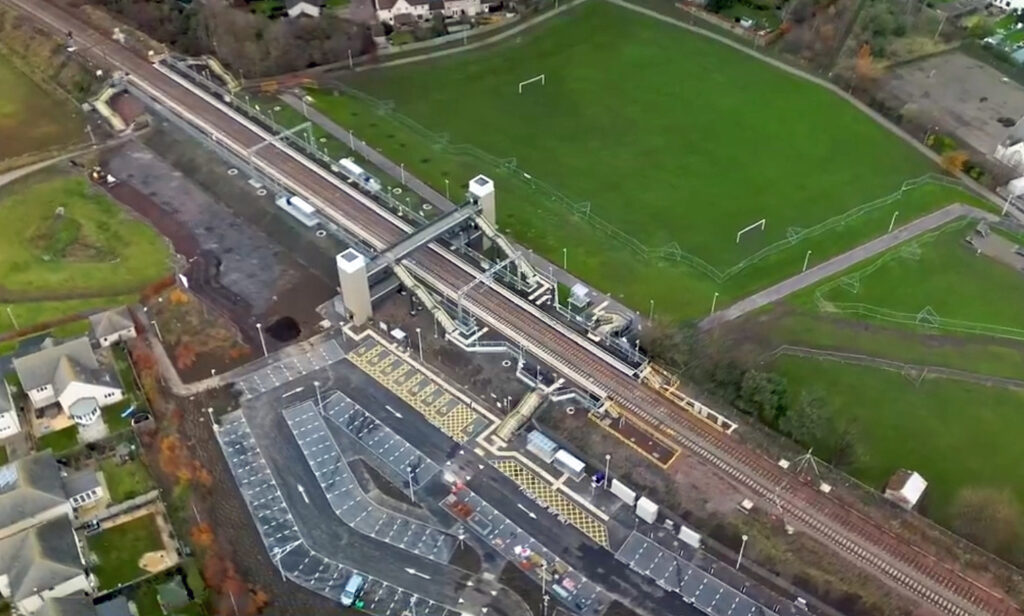The UK mainline network had 2,581 stations as at the end of 2023. Last year saw the opening of seven stations: Reading Green Park; Marsh Barton near Exeter; Thanet Parkway; Portaway Park and Ride near Bristol; Headbolt Lane on Merseyrail; Brent Cross West; and East Linton in Scotland.
Since rail privatisation in 1994, 123 new UK mainline stations have been opened. Of these, 34 are in Scotland which comprises about 10% of the network. One reason why a higher percentage of new stations are opened in Scotland is that 13 of them are on newly opened rail lines. These are those shaded in the table. A further two stations will be opened when the Levenmouth branch is re-opened later this year.
When it opened in 2015, the 35-mile-long Borders Railway was the UK’s longest new domestic railway to be built for over 100 years. Prior to this, the Scottish Borders was the only mainland region of Great Britain without a railway station. It now has four, three as a result of the Borders Railway and Reston station which opened in May 2022.
With the seven new stations provided by the Borders Railway, a total of 20 new stations within commuting distance of Edinburgh have opened over the past 30 years.
As shown on the map, new station openings are not limited to the Scottish central belt with, for example, Inverness and Aberdeen having respectively three and two new stations within their catchment area.

East Linton
Between 1999 and 2013, no less than seven reports were produced considering new rail services in East Lothian and the eastern Scottish Borders. The last report noted that East Lothian had the highest rate of population growth in Scotland. It demonstrated that coach-based options did not meet the transport planning objectives and concluded that there was a strong socio-economic case and a good benefit cost ratio for new stations at Reston and East Linton.
For Reston, the key benefit is regeneration of the Berwickshire area, while for East Linton the re-opening case is based more on achieving modal shift and sustainable development of the rapidly growing area.
Both Reston and East Linton were provided with stations in 1846 with the opening of the Edinburgh to Berwick-upon-Tweed railway which is now the East Coast Main Line (ECML). Both these stations closed in May 1964 after being listed for closure in the Beeching report. A new station at Reston opened in May 2022 as reported in issue 196 (May-Jun 2022). This was followed by the recent opening of East Linton in December. As the original station was on a curve, the new station is on straight track further to the west.
The £15 million East Linton station project, for which East Lothian Council has contributed £3.5 million, was built by BAM Nuttall and designed by ARUP. After a consultation exercise, planning permission for the station was submitted in December 2020 and approved in September 2021.
This was for a station with two 158-metre-long platforms, fully accessible with step-free access across the railway via a footbridge with lifts, cycle storage facilities, a 114-space car park including 18 electric vehicle charging points, a bus shelter, and drop-off space.
Preparatory site work commenced in December 2021 after which station platform piling started in February 2022. This was done on Saturday and Sunday nights until the end of March. Wherever possible, vibration piling was used to avoid neighbour disruption.
Platform construction commenced in May with the use of a crane to lift platform sections onto the piles. As this progressed, a gap was left until two new overhead line equipment (OLE) gantries were installed early in June. These replaced single masts where the platforms were to be. Construction of the new station also required additional signals to be provided.

The lift shafts were installed in September, followed by the footbridge in October 2022. This was followed by the provision of stairs, station fit out work, and the construction of the station car park.
On 13 December, the station opened with suitable ceremony at which Scottish Transport Minister Fiona Hyslop unveiled a plaque, with a piper and local school children greeting the first train. TransPennine Express also named its first unit to stop at the station after a local landmark, Hailes Castle.
The new station is served by ScotRail and TransPennine Express and offers services to Edinburgh Dunbar and Newcastle. It has respectively 22, 23, and nine trains per day on weekdays, Saturdays, and Sundays. Around 130,000 journeys are expected to be made to and from station in the first year of its operation.
Markle crossing
As described in the feature, the new East Linton station required OLE and signalling alternations. It has also accelerated plans to close the nearby half-barrier crossing on the ECML, 1.6km northwest of East Linton station. With two fatalities in the past 15 years, this is regarded as a high-risk crossing. The new station increases this risk as road users might become impatient with the longer wait for trains stopping at the station and weave through an open gap in the barriers.
To eliminate this risk, Network Rail, in consultation with Transport Scotland, has developed an £8.7 million scheme to build a bridge over the ECML for which planning permission was received in May 2023.
Image credit: David Shirres / Network Rail


